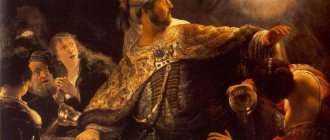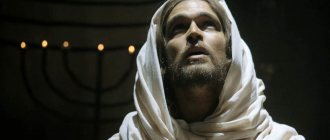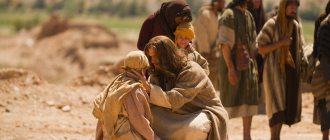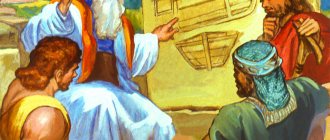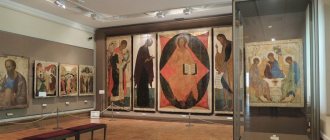Author
The painter, whose full name is Rembrandt Harmens van Rijn (1606-1669), is the largest representative of Dutch painting, its so-called golden age, the 17th. The richest human emotions and feelings of the heroes of Rembrandt’s paintings, which he introduced in such diversity into fine art, elevated the artist to the pedestal of the greatest master of portraiture. The painter's tool for animating his characters and endowing their images with eloquence was chiaroscuro, according to which Rembrandt was a magician and wizard.
Links[ | ]
- On the Hermitage website
- Wikimedia Commons has media related to Return of the Prodigal Son
- [1]
| Rembrandt | ||
| Paintings |
| |
| Engravings |
| |
A short excursion into the subject
Biblical subjects are frequent themes in the works of many artists. At the end of his life, the great Rembrandt also came to the return of the prodigal son as the most poignant moment from the famous parable.
The Bible tells the story of one of the sons of a rich man who turned to his father with a request to allocate his share of the inheritance. He reluctantly fulfilled the wishes of his youngest son, who immediately went to spend easy money: travel, pleasure, feasts with numerous friends, the same revelers. Having quickly spent all his funds, the son was faced with poverty, humiliation and hunger. To get shelter and meager food, he hired himself out as a swineherd. But he soon realized that all that was left was either to die or to return to his father and beg for his forgiveness. It’s better to work hard from dawn to dusk in your father’s house, where the workers are well-fed, dressed, and no one bullies them.
Before the audience is the final scene of the gospel parable.
Parable of the Prodigal Son
The parable of the prodigal son is one of the most famous. Some of its expressions have entered ordinary spoken language, and individual illustrations and paintings related to it have been known to us since childhood.
In the previous two parables about the lost sheep and the lost coin, Christ, calling people to repentance, said that there is joy among the Angels of God over one sinner who repents (Luke 15:10). In order for the words of repentance to be more deeply imprinted in the hearts of His listeners, Christ further pronounces the parable of the prodigal son. This parable is a continuation of Christ's response to the reproaches made to Him by the Pharisees that He receives sinners and eats with them (Luke 15: 2). We find the parable of the Prodigal Son, like the previous two, in the 15th chapter of the Gospel of Luke:
“A certain man had two sons. And the youngest of them said to his father: Father! give me the next part of the estate. And the father divided the estate to his sons. After a few days, the youngest son, having collected everything, went to a distant place and there squandered his property, living dissolutely. When he had lived through everything, a great famine arose in that country, and he began to be in need. And he went and accosted one of the inhabitants of that country, and he sent him to his fields to graze pigs. And he was glad to fill his belly with the horns that the pigs ate, but no one gave it to him. Having come to his senses, he said: “How many of my father’s hired servants have an abundance of bread, but I am dying of hunger; I will get up and go to my father and say to him: Father! I have sinned against heaven and before you and am no longer worthy to be called your son. Take me among your mercenaries. He got up and went to his father. And while he was still far away, his father saw him and took pity; and, running, fell on his neck and kissed him. The son said to him: Father! I have sinned against heaven and before you, and I am no longer worthy to be called your son. And the father said to his servants: Bring the best robe and dress him, and put a ring on his hand and sandals on his feet. And bring the fatted calf and kill it. Let's eat and have fun! For this son of mine was dead and is alive again; he was lost and is found. And they started having fun. His eldest son was in the field; and returning, when he approached the house, he heard singing and rejoicing; and calling one of the servants, he asked: what is this? He said to him: Your brother has come, and your father has killed the fatted calf, because he received it healthy. He became angry and did not want to enter. His father came out and called him. But he answered his father: Behold, I have served you for so many years and have never violated your orders; but you never gave me even a kid so that I could have fun with my friends; and when this son of yours, who had wasted his wealth with harlots, came, you killed the fatted calf for him. He said to him: My son! you are always with me, and all that is mine is yours; and in this you had to rejoice and be glad, because this brother of yours was dead and is alive again, he was lost and is found” (Luke 15:11-32).
The parable of the prodigal son is inexhaustible. It contains so many topics that it is difficult to list them. Every person who reads it with reverence finds answers to questions about their own spiritual state.
The first theme is historical – the theme of the chosen people of God and the pagans. The eldest son in the parable could be an image of Israel, and the youngest - of the pagan nations. In the light of this parable, according to Rev. Michael Pomazansky, one can understand the meaning of the Old Testament period, when people, having committed original sin, moved away from God. “A father mourns the passing of his beloved son. But, without violating his filial dignity and filial freedom, He waits until the son, having learned all the bitterness of evil and, remembering his former life in the Father’s house, himself yearns for this house and opens his soul to the Father’s love. So it was with the human race."
The second topic is about the nature of sin. That is why the parable of the prodigal son is read during the Liturgy on the third preparatory Sunday before Great Lent, when believers prepare for cleansing from sins through the feat of repentance.
Repentance is the third theme. Nowhere better does the Gospel reveal to us the essence of repentance than in the parable of the Prodigal Son. It reveals to us the gradual internal process of the sinner’s revolution and the fullness of repentance, which consists in the awareness of one’s fall, sincere repentance and humble appeal to the Heavenly Father.
The fourth topic is the Church and its liturgical life. This is stated in the Synaxarion of the Week about the Prodigal Son (a special teaching that is read on this Sunday preparatory to Great Lent). The “best clothes” in which the father dresses his returning son are interpreted in the synaxar as baptism, the “ring” as sealing by the Holy Spirit in the sacrament of Confirmation, the “feast with eating the fatted calf” as the Eucharist, the sacrament of Communion. “Singing and rejoicing (music)” is a symbol of the triumph of the Church regarding its restored fullness and unity.
The fifth theme that we encounter in the parable of the Prodigal Son is the Savior Himself, Who appears here in the Eucharistic image of the slaughtered calf, for He is mentioned in Scripture as the Lamb of God, Who takes away the sin of the world (John 1: 29).
The image of the eldest son reveals the theme of envy, conceit, legalism and the theme of the need for mutual, fraternal forgiveness.
“The Younger, Prodigal Son” is a prototype of all fallen humanity and at the same time of each individual sinner. "The next part of the estate", i.e. the share of the estate of the youngest son is the gift of God with which every person is endowed. According to the explanation of Bishop. Ignatius Brianchaninov is “... the mind and heart, and especially the grace of the Holy Spirit, given to every Christian. The father’s demand for the next part of the estate to be used arbitrarily is a person’s desire to overthrow his obedience to God and follow his own thoughts and wishes. The father’s consent to the issuance of the estate depicts the autocracy with which God honored man in the use of God’s gifts.”
Prot. Alexander Men, in one of his sermons on “The Week of the Prodigal Son,” notes an interesting economic detail: “In those times that the Lord talks about, people tried to live as one family. It is now more natural for children to separate and move away from their parents as they grow up. Then people jointly owned the land, which they cultivated together, and the larger the family, the more workers there were, the more opportunities to work. Therefore, dividing a house, dividing an estate and a household was considered damage, loss. If children did this, it was considered an insult to the parents.”
Having received his part of his father’s property, the youngest son goes “to a distant country,” to a foreign land - a place of separation from God, where he stops thinking about his father, where he “lives dissolutely,” that is, he indulges in a sinful life that alienates man from the Creator. There he quickly squandered his possessions, his share of God’s gifts: strength, mind, heart and body. This leads him to poverty - complete spiritual devastation. This is not surprising, for a person who has entered the path of sin follows the path of selfishness and self-indulgence. He does not truly own what brings him momentary pleasure, but he owns what delights him. That's why ap. Paul warns Christians: “Let nothing possess me” (1 Cor. 6:12).
On this occasion, one church thinker wrote: “...This far side, this foreign land reveals to us the deep essence of our life, our condition. Only by understanding this can we begin to return to authentic life. Anyone who has not felt this at least once in his life, who has never realized himself spiritually in a foreign land, separated, exiled, will not understand what the essence of Christianity is. And those who are completely “at home” in this world, who have not experienced longing for another reality, will not understand what repentance and repentance are. ...Repentance and repentance are born from the experience of alienation from God, from the joy of communion with Him. … It necessarily includes a deep desire to return, to return, to find the lost home again.”
In the days of preparation for Great Lent, starting with the week of the Prodigal Son, the Church sings the psalm “On the Rivers of Babylon,” which recalls the bitter captivity of the Jews in a distant land. This is a symbol of the captivity of sin, which alienates a Christian from God. But this psalm also speaks of repentance, love and returning to the father’s home. Having squandered his estate, the youngest son begins to starve. In order not to die of starvation, he becomes a pig herder - a swineherd. And he would have been glad to be satisfied with pork food - “horns”, but no one gave it to him. After much suffering, a saving thought awakens in him: “How many of my father’s hired servants have an abundance of bread, but I am dying of hunger.” The prodigal son could come to such a thought due to the fact that he did not have time to squander his last gift - the gift of memory of his father and his father's house, in other words, conscience (the voice of God within us).
And just like that, after a serious illness accompanied by unconsciousness, consciousness returns to him, and he understands his plight. Then the determination appears in him to leave his sins and repent, realizing that he has offended the Lord with them, and, finally, in deep humility and awareness of his unworthiness, which always accompanies sincere repentance, the sinner actually realizes his determination and returns to his father. It should be noted here that external disasters are often sent by God to sinners in order to admonish them. This is God's call to repentance.
Ep. Theophan the Recluse, an experienced student of spiritual life, compares a sinner with a person immersed in a deep sleep, and in his appeal to God, he notes three psychological moments that correspond to those indicated in the parable: 1) awakening from a sinful sleep (Luke 15: 17); 2) the maturation of the determination to leave sin and devote oneself to pleasing God (Luke 15: 17–21); and 3) endowing the sinner with power from above in the sacraments of Repentance and Communion.
In this parable, multifaceted in content and remarkable in its brightness of colors, where the Heavenly Father is meant by the image of the father of two sons, perhaps the main place is occupied by the behavior of the Father, His kindness that surpasses all human concepts, love for the sinner and joy at the return of the prodigal son to Him. . “...While he was still far away, his father saw him,” the Gospel tells us, which means that the father waited and, perhaps, watched every day to see if his son was returning. “I saw it and took pity, and ran, threw myself on his neck and kissed him.” The son began to confess, but the father did not let him finish; he has already forgiven and forgotten everything and accepts the dissolute and hungry swineherd as his beloved son. The father did not demand evidence of his son’s repentance, because he saw that his son had overcome shame and fear to return home. He tells his servants to give him the best clothes, shoes and a ring on his hand. The ring is an indication of God's gift to the forgiven sinner - the gift of God's Grace, in which he is clothed for the salvation of the soul. According to the interpretation of blessed. Theophylact's ring in the parable testifies to the renewed unity of the sinner with the earthly and heavenly Church.
It is difficult to convey in words the fullness of God's love for fallen sinners. Perhaps no one better reveals to us this love of God, about which we read in the parable of the Prodigal Son, than the apostle. Paul in his first letter to the Corinthians: “Love is patient and kind, … love is not proud, … is not easily provoked, and thinks no evil. He does not rejoice in untruth, but rejoices in the truth. He bears all things, believes all things, hopes all things, endures all things” (1 Cor. 13: 4-7). It is appropriate to mention here that every sin is a crime against love and that true repentance can only be accomplished in the face of Perfect Love, for God is Love (1 John 4:8).
It is necessary to especially emphasize the reason for the father’s joy: “My son was dead and has come to life; was lost and is found,” i.e. was spiritually dead, living without God, and spiritually revived, turning to life in God. In Scripture, the return to God is often presented as the resurrection from the dead (see Rom. 6:13; Matt. 8:22; Rev. 3:1; Eph. 2:1).
Let us now turn to the image of the eldest son. The eldest son was unhappy with the return of his younger brother and his reconciliation with his father. This is how it is stated in the parable: “And his eldest son was in the field; and returning, when he approached the house, he heard singing and rejoicing; and calling one of the servants, he asked: what is this? He said to him: Your brother has come, and your father has killed the fatted calf, because he received it healthy. He became angry and did not want to enter. His father came out and called him. But he answered his father: Behold, I have served you for so many years and have never violated your orders; but you never gave me even a kid so that I could have fun with my friends; And when this son of yours, who had wasted his wealth with harlots, came, you killed the fatted calf for him.”
By the eldest son, Jesus Christ primarily meant the Pharisees and scribes - the elders of the people, who with their legalism prevented people from coming to Him. But this image equally applies to all of us, to our relationships. The eldest son was not guilty before his father, he did not actively sin against him until his sinful brother returned. The return of the prodigal brother aroused envy in the eldest son - this terrible sin, which led to the first human murder and to the murder of the Savior Himself. In the house of the Father (the image of the Church) there is joy, rejoicing - the rejoicing of the angels over the one sinner who repents, but this joy is outside the soul of the eldest son. The father invites the eldest son to enter into this joy, but he chooses the path of calculations, the path of legal relations, the contract. Such cold, legalistic relationships always take over where love dries up. The eldest son's statements indicate that he did not truly value his father's gifts, which he enjoyed. He did not appreciate them, because in his soul there was a more terrible emptiness than the one that we saw in his brother before repentance. The eldest son drowned out the voice of his conscience.
We all, to one degree or another, at one time or another in our lives, behave like sons of a merciful father. We are all alienated from His love through our sins. The service on the week of the Prodigal Son reveals to us the state of alienation from God: “I spent fornication on my father’s wealth, and having wasted it, it became empty, and wicked citizens moved into the country...”
This is the state the prodigal son was in for a long time and finally, says the Gospel parable, “came to his senses.”
What does “come to my senses” mean?
One Holy Father says that the beginning of our salvation is knowing ourselves. But knowing oneself is the work of one’s whole life, this is what a person strives for throughout his entire existence. The Holy Fathers reveal the meaning of this saying, saying that until you knew who you are, until you felt the image of God in yourself, until you, living among earthly citizens, felt that you were a citizen of heaven and enslaved " alien citizens,” until you, living among the filth of your own soul, recognized the image of God in yourself, until then you did not enter the path of salvation, you had not yet begun your salvation. It begins from the moment you realize your divine nature. So it was with the prodigal son. At one moment he felt that he was living enslaved “in a foreign country” and had no real real life. Having started with the knowledge of himself, a person, going further along this path, contrasts in himself what is in him from the image of God, although covered with the sores of sins, with the way he lives. And from this moment he begins to thirst for life in God and cleansing himself from the wounds of sins in the name of the image of God.
To Rev. One monk came to Anthony and began to ask him to forgive and have mercy on him. Anthony answered him: “Neither I nor God will have mercy on you if you do not have mercy on yourself.”
At first glance, the answer seems strange. How so? This is the greatest truth for spiritual life. Until I myself find the image of God in myself, I myself will not have mercy on the inner man who is in the abyss of sin, but has the image of God, until I myself have mercy on the creation of God in myself, in my conscience I will not have mercy on myself, a sinner, a bad person. and the prodigal, that is, I will not have pity on my immortal soul, until then God will not have mercy on me, until then my prayer is in vain.
This is the state of the prodigal son, who saw how badly he lives and how well not even his sons, but his father’s hired servants live - this is the state of pardon. He had mercy on himself and then went to God and began to ask Him for mercy. We must take from the patristic experience what it gives us, otherwise our requests for mercy will be in vain. We must feel the image of God in ourselves, the remnants of divine beauty that are in us, although distorted, and first of all, have mercy on ourselves, understand who we are in life and who we are in creation.
In life, we are sinners, living in a “far away country,” constantly forgetting about God, and in creation, we are the image of God’s “ineffable Glory,” and only in Him do we live, only in Him is our salvation.
And this opposition between oneself in creation and oneself in life gives, at a certain moment, a state of self-pardon. This is the meaning of the word rev. Antonia. And if at some point in our lives we have mercy on ourselves and feel the contrast between ourselves in creation and ourselves in life, then we can, like the prodigal son, go to God and ask for mercy. We must restore the image of God in ourselves, we must understand that our only business on earth, we, citizens of the earth, is to become citizens of heaven. If we constantly have before our eyes the creation of God, the image of the “ineffable Glory of God,” then we will have mercy on ourselves. This does not mean that we will be proud, forgive ourselves, make excuses, but we will see in ourselves the ineffable temple of God’s Glory, we will feel all the joy of life in God and feel the dirt in which we live. Then we will come to God and ask Him like the prodigal son: “Take me as one of Your hired servants,” and we will be accepted like the prodigal son.”
Description of the picture
The action takes place in front of the entrance to the house. The son, who has returned to the family, is depicted with his back to the viewer. In sincere repentance, he fell to his knees and fell to his old father. The young man’s face is not visible, only the back of the unfortunate man’s shaved head - he, like a child, buried himself in his father’s clothes. The father, leaning towards the returning child, who had done a lot of stupid things, but had matured, bent over him and reverently hugged him with both hands, like an eagle with its wings, protecting and protecting its chick. By the appearance of the prodigal son in the picture one can judge the ordeals that befell him: worn-out shoes are worn out to the limit, once rich clothes are torn. One shoe fell off his foot - along with his cracked, dirty foot, one can clearly see the desperate impulse with which the young man rushed towards his father.
The figure most carefully depicted in Rembrandt's Return of the Prodigal Son is the father. His appearance contains everything: forgiveness, bitterness over lost time, and compassion. The depth of his love is masterfully conveyed by the artist - without meaning to, viewers involuntarily empathize and peer into the canvas even more closely, wanting to see the smallest details.
On the right, looking sternly and puzzledly at his brother, who suddenly returned to the bosom of the family, stands the eldest son - he has worked righteously all his life, and now his feelings are confused. There is a struggle going on inside him - he is angry with his father, with his brother, with the very situation of his sudden return.
In addition to the main characters, there are three more characters in the picture. Art historians do not give a definite answer to who they are. Presumably the seated person is a relative, and the people in the shadow are servants. Their location, as well as the degree of illumination, speaks of the secondary importance of the heroes.
Why did Rembrandt leave so many mysteries in the painting “The Return of the Prodigal Son”?
The weather was rainy. I saw my son off at the station. He was leaving me. Left forever...
Father and son
Homer, Confucius, Rembrandt, Jan Steen, Turgenev, Dostoevsky, and our contemporaries: Alexander Vampilov and Andrei Tarkovsky thought about them. And everyone noticed how thin the thread was that connected father and son, and everyone touched it in their own way, touched it and realized that it was thinner than the thread of a silkworm.
But it was Rembrandt van Rijn in “The Return of the Prodigal Son” who left the most questions and mysteries.
Is it because for the image of his father he did not take a mere mortal, say, his own father, a miller. Is it because he managed to bury two wives and a 27-year-old son? Was it because he himself had been stripped to the skin and knew that his earthly life was numbered, which meant he was preparing to meet his son.
Why were these five plot moves made by Rembrandt one step away from death?
1. In the Gospel of Luke, Jesus told the parable of the Prodigal Son to the Pharisees. For what? What was his meaning? Maybe it was about the fact that he himself would have to appear before his father - the Heavenly Father. Therefore, in the film, all participants are clearly fascinated by the mystery of the meeting. Rembrandt highlights the holy place, and the scene is as abstract as possible from everyday life. (In the paintings about the prodigal son by Guerzino and Murillo we see vanity). Even the fallen sandal on the son’s foot emphasizes the presence of a holy place. (It is indicated in the scene where God says to Moses: “Take off your sandals from off your feet, for the place on which you stand is holy ground” (Ex. 3:5)).
2. Let's take a closer look at the Father. He bears the features of divinity: he repeats the shape of an arch, does not have a headdress, he has a blissful face and clearly different hands: male and female - which means he combines paternal and maternal love, which is characteristic of God. It is clear why there is no mother. The woman in the upper left corner, even in the shadows, does not show maternal joy, does not extend her hands, and is in no way suitable for the role of a mother.
3. The image of a wandering son in rags and the shaved head of a convict with scars is convincingly created. At the same time, Rembrandt hides his face. (All artists show it: Dürer depicts repentance, Jan Steen - prayer, van Leyden - exhaustion, Masseys - fear, Guerzino - obedience, Murillo - beating forgiveness). But there was no hard labor, otherwise he would not have kept his tattered but expensive collar. (Gwercino and Murillo have brought clothes, and the son will now perk up). This means that his unforgiven life was harder than hard labor!
Suits
The clothes on the characters are most likely from the artist's collection. At that time, Holland was an economically extremely developed country. Merchant seafarers moved around the world and traded even with Japan, which at that time had no commercial contacts with other countries. The ports of Holland were the richest accumulations of goods outlandish for the northern country. Rembrandt loved to visit port markets, where he bought fabrics, costumes, jewelry, household items and weapons. All this splendor then appeared on the master’s canvases. Even for self-portraits, the artist dressed in overseas outfits - it was interesting for a creative person to try on other people's images.
Literature[ | ]
- Vertsman I.
Rembrandt and realism // Nevezhina V. M. Rembrandt. L., 1935. S. 119-137. - Lyuban G.
Return of the Prodigal Son. More than the eye can see. M., 2007. - Fechner E.
Return of the Prodigal Son. Leningrad: State Hermitage Publishing House, 1963. - 24 p. - Benesch O.
Rembrandt: Étude biographique et critique. Genève: Skira, 1957 - 156 pp. - Wencelius L.
Calvin et Rembrandt: Étude comparative de la philosophie de l'art de Rembrandt et de l'esthétique de Calvin. Paris: Les belles-lettres, 1937. - 239 p.
Expressive composition
Rembrandt in his works used light as a pointing finger, defining the main thing.
In the painting “The Return of the Prodigal Son”, using this technique, the artist primarily highlights the father - his forehead is the brightest spot in the picture. This means that the closest attention should be paid to this character. Then the sons - the youngest, lost and come to his senses, and the eldest, serious and responsible.
The father and the younger man occupy the left side of the picture – they are highlighted by the light and the red color of the old man’s cape. The artist achieves visual balance by placing the figure of his eldest son near the right field of the canvas, he is also in red. The semantic center is placed according to the law of the golden ratio, known since ancient times.
Chiaroscuro and color contrasts weaken as you move deeper from the foreground - the space is seen as deep and real when the outlines and faces of the witnesses to the scene of the meeting between father and son weaken as they move away and dissolve in the darkness.
Notes[ | ]
- Media files on Wikimedia Commons
- Portal "Painting"
- Project "Famous Paintings"
- ↑ 12
Composition Basics - Return of the Prodigal Son Archived October 30, 2014 on the Wayback Machine
- N. Volkov. "Composition in painting." M., 1977
- Luban, G. Return of the Prodigal Son. More than the eye can see. M., 2007. P. 25
- Return of the Prodigal Son
- Highest maturity of skill. Results. Part 4
- Return of the Prodigal SonHenry Nouwen
Rembrandt technique
The artist’s goal is to convey the deep experiences of the characters, their inner world. This is what the painter is focused on. This is reflected in his technique. The color scheme differs from the standard one - it is an alloy of warm brown, red and golden shades.
The strokes are applied impetuously, confidently and as if carelessly - a common technique for oil painting. There is no attempt by the artist to hide them or smooth them out. This allows you to convey images as realistically as possible. This means allowing the viewer to feel the depth of the characters’ experiences.
The same parable in the artist's works
During his life, Rembrandt took up the same theme more than once.
Four of his experiences with the main character, the prodigal son, are known:
- “The Prodigal Son in the Tavern”, aka “Self-Portrait with Saskia on Her Knees” (1633). At that time, Rembrandt was a happy newlywed, cheerful and carefree. He is a fashionable portrait painter, makes good money and at the same time married for love a girl from a wealthy family... The scene in the picture corresponds to the period of carefree pastime of the prodigal son from the parable.
- Etching “The Prodigal Son” (1636), in which the focus is on the father, hurrying to his son, so that the shoe falls off and the cane falls out of his hands.
- Drawing in brown tones of a search for key points, painted in 1642 (exhibit at the Tayler Museum in Harlem).
- That same “Return of the Prodigal Son” (1666-1669), written not by order, but by his own impulse, as a cry from the soul and the result of life’s journey.
All works bear traces of changes and author's corrections, which are noticeable on the x-ray and indicate their authenticity.
The fate of the artist
Rembrandt was born in Leiden into the family of a wealthy Dutchman who owned a mill. When the boy announced to his father that he intended to become an artist, he supported him - then in Holland it was prestigious and profitable to be an artist. People were ready to go hungry, but did not skimp on paintings.
After studying for three years (which was enough to start his own business, as was then believed) with his uncle, a professional artist, Rembrandt and a friend opened a workshop in Leiden. Although there were orders, they were rather monotonous and did not captivate. Work began to boil after moving to Amsterdam. There he soon met Saskia van Uylenburch, the daughter of the burgomaster of Leeuwarden, and without thinking twice he got married.
Personal tragedy of the master
Rembrandt began “The Return of the Prodigal Son” in the last years of his life after a terrible misfortune, which, among others, threatened to completely destroy the artist. By this time he was abandoned by his students, ridiculed by society, and ruined. Now his 26-year-old son Titus, whose mother was Rembrandt's first wife, his beloved Saskia, has died. Before Titus, the couple had three more children who died in infancy. At the age of 10 months, Titus himself lost his mother and was raised by his loving father. Outlived Rembrandt and Hendrickje, his son's nanny and maid, who became his unmarried wife and his son's mother. Following Titus, Rembrandt’s daughter-in-law, who lived with her husband for only six months, passed away...
Titus was a caring son who devotedly believed in his father's genius. When creditors deprived Rembrandt of his home and his magnificent collection (which even included drawings by Leonardo da Vinci), the artist moved to the outskirts of the city. Titus undertook to sell his father's works, but they were rarely sold profitably; then he took paintings by other artists for sale. With the sole purpose of ensuring that my father could work peacefully in the workshop.
Now the old, sick Rembrandt has lost his dearest person, his son, who died of consumption. Only work could save the painter from madness.
The prodigal son is the image that will save, and Rembrandt, in the image of a gentle father, will again be able to touch his son and hug him. The weak artist was then barely able to hold a brush and tied it to his hand to paint. I couldn't see well - I looked through a magnifying glass. But he finished his masterpiece, unsurpassed in conveying the emotions of his father, who is still the main character of the work.
Art critics believe that the main characters (father and two sons) symbolize Rembrandt himself at different periods of his life, full of passions, quests and suffering.
The role of the painting in world culture[ | ]
Chris Kelvin returns to his father in the final scene of A. Tarkovsky's film "Solaris" (1972)
- Henry Nouwen, the 2nd most widely read Christian author in the United States after Clive Lewis, once saw a reproduction of this painting and went to Russia to enjoy the original. The picture made him take a fresh look at the parable, and later he wrote a Christian essay, which he called “The Return of the Prodigal Son.” In it, he examines the three stages of each person’s spiritual journey through the prism of a parable[7].
- Benjamin Britten's opera "Prodigal Son"
was composed in 1968 after visiting the USSR (at Christmas 1967, together with the famous English tenor and close friend Peter Pears), where in Leningrad (during an excursion to the Hermitage) the composer was greatly impressed by a painting by Rembrandt . - In 1970, the USSR Ministry of Communications issued a postage stamp with a reproduction of this painting, the denomination of the stamp is 12 kopecks (No. 3959 according to the DFA catalog).
The image of the prodigal son is widespread in art
The story of the prodigal son has long been of concern to representatives of the arts. The plot of the parable was used by many writers to write literary works.
Artists also widely use it in their work. Films are made based on it, theater productions are staged, and operas are written.
Prodigal son. James Tissot. 1882 The plot of the parable of the prodigal son is popular among artists and other cultural figures. Paintings are painted on it, films are made, operas are staged.
In ordinary life, a prodigal son is understood as a person who, looking for a new life, left his father’s house or group.
Then, repentant, he returned. This phraseological unit is also often found in works of art, but, unlike the parable, it does not have a religious meaning.
By leaving a comment, you accept the user agreement
The father himself met the prodigal son, fell on his neck and began to kiss
And the prodigal son went to his father. When he had not yet approached his house, his father saw him and took pity on him. He himself ran towards his son, fell on his neck and began to kiss him. The son began to say to him:
“father! I have sinned against heaven and before you, and am no longer worthy to be called your son...”
"Return of the Prodigal Son", Rembrandt Harms van Rijn, c.
1666. Seeing the prodigal son, his father threw himself on his neck, began to cry and kiss him. The father ordered his servants to bring the best clothes and dress him. In addition, he ordered that a ring and shoes be put on his son. After this, his father slaughtered a fattened calf for him and said:
“... let's eat and have fun! Because this son of mine was dead and is alive again; I was lost and found!”
And the feast began.
The eldest son was walking from the field at that time. He heard people singing and rejoicing at home and asked one of the servants what was happening there. The servant replied that his brother had returned. In honor of this, the father ordered the fattened calf to be slaughtered. He is glad to see him healthy.
Video: The Parable of the Prodigal Son, Scriptwriter Oleg Kozyrev, director Sergei Antonov. The cartoon conveys the full content of the parable of the prodigal son.
The eldest son was angry at this and did not want to enter the house. His father himself came out to him and began calling him. But he began to reprimand his father that he had served him for many years and had never violated his orders.
The father did not even give the eldest a kid so that he could have fun with his friends. At the same time, for the returning youngest son, who had wantonly squandered his property, he slaughtered a fatted calf!
To this his father said to him:
"my son! you are always with me, and everything that is mine is yours..."
He also pointed out to him that he should rejoice that his brother had returned. This is where the parable ends, and the ending of this story is not given in the parable.
